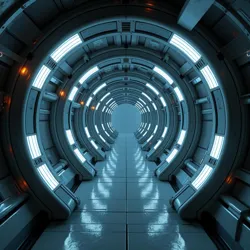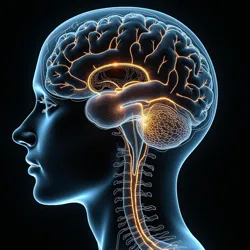Deep Space Adaptation
Deep Space Adaptation (DSA) refers to the complex series of physiological and neurological changes that occur in human beings during extended periods of interstellar travel. This phenomenon encompasses both natural evolutionary responses and deliberately induced modifications that enable humans to better survive and function in the unique conditions of deep space environments.
 A modern Deep Space Adaptation Chamber aboard the research vessel Stellar Horizon, equipped with neural resonance amplifiers and gravitational field modulators
A modern Deep Space Adaptation Chamber aboard the research vessel Stellar Horizon, equipped with neural resonance amplifiers and gravitational field modulatorsHistorical Background
The field of Deep Space Adaptation emerged in the early days of interstellar exploration when researchers began noticing unexpected changes in long-term space travelers. The discovery of Speech Pattern Glands by Dr. Mira Voss marked a turning point in understanding how the human body naturally adapts to deep space conditions. This led to the establishment of the Interstellar Adaptation Institute and the development of the first formal adaptation protocols.
The Great Void Expedition of 2157 provided the first comprehensive data on natural adaptation processes, as the crew experienced significant physiological and neurological changes during their unprecedented three-year journey through regions of minimal stellar activity. These observations formed the foundation of modern adaptation science.
Physiological Changes
Neural Restructuring
The most significant changes occur within the human nervous system, particularly in regions associated with spatial awareness and consciousness processing. The development of void-sense neurons enables individuals to perceive and navigate through space in ways previously thought impossible.
Extended exposure to deep space conditions triggers the formation of new neural pathways, particularly in the:
- Temporal processing centers
- Spatial orientation networks
- Consciousness synchronization regions
- Gravitational adaptation centers
Sensory Enhancement
Deep space adapters typically develop heightened sensory capabilities, including:
- Enhanced perception of electromagnetic fields
- Improved ability to detect gravitational variations
- Increased sensitivity to stellar radiation patterns
- Development of space-time orientation sense
 Advanced imaging showing the development of new neural pathways in deep space adapted individuals
Advanced imaging showing the development of new neural pathways in deep space adapted individualsAdaptation Protocols
Natural Adaptation
Natural adaptation occurs gradually over extended periods in deep space and typically follows several distinct phases:
Initial Phase (0-6 months)
- Activation of dormant neural tissues
- Development of preliminary void-sense capabilities
- Beginning of gravitational independence
Intermediate Phase (6-18 months)
- Formation of new neural pathways
- Enhancement of sensory capabilities
- Development of stellar resonance sensitivity
Advanced Phase (18+ months)
- Full integration of new neural networks
- Mastery of void-sense navigation
- Development of enhanced consciousness synchronization abilities
Artificial Acceleration
The development of artificial adaptation techniques has made it possible to significantly reduce the time required for deep space adaptation. These methods include:
- Application of specialized neural resonance fields
- Use of targeted genetic activation protocols
- Implementation of advanced meditation techniques
- Exposure to synthetic stellar radiation patterns
Medical Considerations
Health Benefits
Successfully adapted individuals often experience numerous advantages:
- Enhanced immune system function
- Improved cellular repair mechanisms
- Better radiation resistance
- Increased longevity in space environments
Risks and Complications
Deep Space Adaptation is not without its challenges and potential risks:
- Neural overload syndrome
- Gravitational readjustment difficulties
- Consciousness synchronization disorders
- Void-sense disorientation
Technological Support
Adaptation Equipment
Modern adaptation facilities utilize various specialized equipment:
- Neural resonance amplifiers
- Gravitational field modulators
- Consciousness synchronization chambers
- Stellar radiation simulators
Monitoring Systems
Continuous monitoring of adaptation progress requires sophisticated technology:
- Neural pathway mapping devices
- Consciousness wave analyzers
- Void-sense activity monitors
- Genetic expression trackers
Social Impact
Cultural Changes
The emergence of deep space adapted humans has led to significant societal changes:
- Development of new social structures in space communities
- Evolution of specialized communication methods
- Creation of adaptation-focused educational systems
- Emergence of unique cultural practices
Professional Implications
Deep Space Adaptation has created new career opportunities and specializations:
- Adaptation specialists
- Void-sense navigation experts
- Neural resonance technicians
- Space-time orientation instructors
Research and Development
Current Studies
Ongoing research focuses on several key areas:
- Optimization of adaptation protocols
- Development of enhanced support technologies
- Investigation of long-term effects
- Study of generational adaptation patterns
Future Directions
Emerging areas of research include:
- Integration with artificial enhancement systems
- Development of rapid adaptation techniques
- Investigation of extreme environment adaptation
- Study of consciousness expansion in deep space
Regulatory Framework
Legal Requirements
The Interstellar Safety Commission has established strict regulations governing:
- Mandatory adaptation periods
- Required medical monitoring
- Certification procedures
- Emergency protocols
Safety Standards
Comprehensive safety measures include:
- Regular neural assessment
- Consciousness synchronization testing
- Void-sense capability evaluation
- Adaptation progress monitoring
Training and Education
Basic Preparation
Initial training focuses on:
- Understanding adaptation physiology
- Learning meditation techniques
- Developing void-sense awareness
- Mastering safety protocols
Advanced Programs
Specialized training includes:
- Neural pathway development techniques
- Consciousness synchronization methods
- Void-sense navigation skills
- Emergency response procedures
See Also
- Void-Sense Navigation
- Neural Resonance Technology
- Space-Time Orientation Training
- Stellar Radiation Adaptation
References
- Journal of Deep Space Medicine
- Adaptation Science Quarterly
- Interstellar Medical Review
- Consciousness Studies in Space